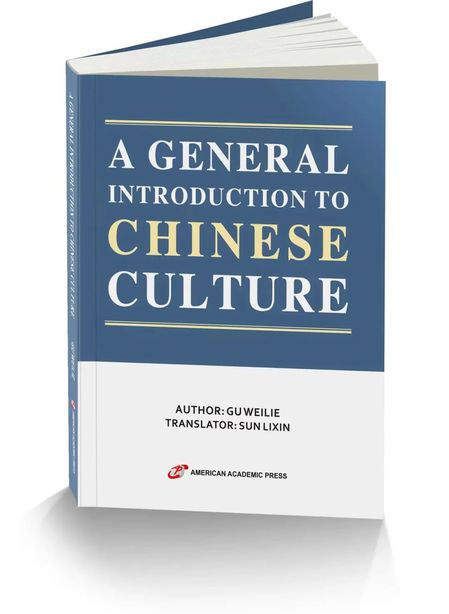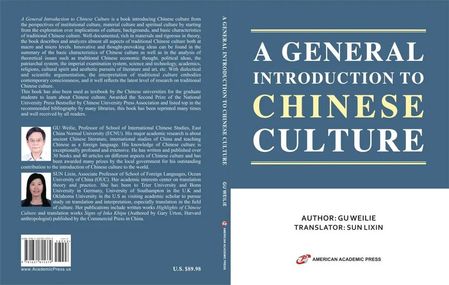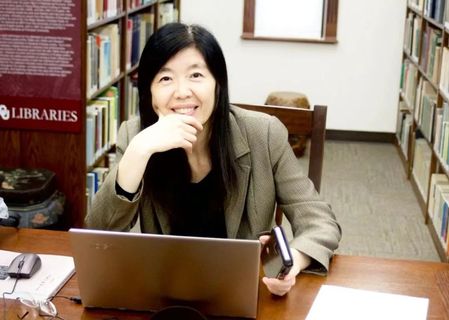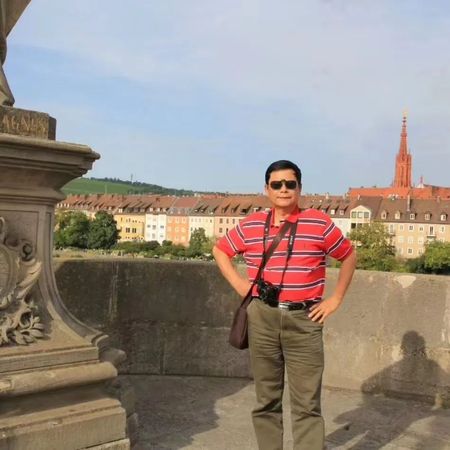《中国文化通论》英文版
顾伟列 著
孙立新 译
出版社:American Academic Press(美国学术出版社)
该成果由国家社科基金中华学术外译项目资助出版

一、主要内容
《中国文化通论》是一部全面系统介绍中国文化的学术著作,全书约40万字。本书从地理环境、农耕经济和社会结构三方面阐述了中国文化的生成背景;从人文性、包容性、伦理型、和谐型、务实精神等方面论述了中国文化的基本特征。本书分为“制度文化”、“物质文化”和“精神文化”三编,对中国文化进行了系统梳理,脉络清晰,论述全面而简洁。“制度文化”编包括经济、政治、职官、宗法、科举、教育、婚姻等文化;“物质文化”编包括服饰、饮食、建筑、交通、科技等文化;“精神文化”编包括学术、宗教、文学、艺术、节日等文化。三编内容基本涵盖了中国传统文化的主要方面。
本书体例规范、纲目清晰、内容丰富、材料详实,既对中国文化作了宏观描述和微观分析,又秉持马克思主义文化观,对一系列理论问题进行了辨证且科学的阐释辨析,具有新意和启发性。
二、成果简介

《中国文化通论》是国家社科基金“中华学术外译”项目的推荐翻译书目,由华东师范大学出版社出版,其英文版由美国学术出版社(American Academic Press)于2022年5月出版发行。
《中国文化通论》中文版理论严谨,史论结合,论析深入,重点突出,文字准确精炼。对中国传统经济思想、政治观念、宗法制度、科举制度、科技文化、学术、宗教及文学艺术的民族特点、文化精神、美学追求等理论问题的梳理、辨析和总结,均能提出具有新意和富于启发性的观点。对中国文化基本特点的归纳,对传统文化的阐释均能体现当代意识,论析辩证而科学,能够反映近年来中国传统文化研究的最新成果。其英文版(A General Introduction to Chinese Culture)力求忠实于原作,基本沿续了原作者的思路和写作风格。在翻译过程中,译者兼顾中西学者的文化差异和国外受众的认知和阅读习惯,运用多种翻译策略,对极具中国特色的文化表述进行了再加工和再提炼,充分发挥语言文字的传达力和感染力,以期更深入有效地对外传播中国文化。
三、学术价值
目前,我国正处于重要的历史机遇期,振兴中华文化,传播中华文明是民族复兴的重大任务和战略课题。积极地实施国际文化传播战略,广泛传播中国文化,增强国家文化影响力和竞争力,这对于提升我国文化软实力具有重要而深远的意义。《中国文化通论》的对外译介是“让世界了解中国,让中国走向世界”的一个重要窗口,将会有助于使越来越多的外国读者更深层次地、更系统地了解中国和中国优秀传统文化的丰富哲学思想、人文精神、教化思想、道德理念等,从而让世界了解中国文化和谐的、内敛的、非侵略性的、主张和平共处的文化传统,将具有中华文化魅力的生存理念植入世界民心,进而推动中国文化和价值观念真正能够对世界产生深远的文化影响,使中国文化在异域文化中走得更远,促进人类文明发展的共同进步。
本项目的翻译工作得到了美国著名汉学家、哲学家费乐仁(Lauren Pfister)教授和俄克拉荷马大学华语译文研究馆(CLTA)石江山(Jonathan Stalling)教授悉心的指导与帮助。
四、目录
Leading-in Introduction
I. Implications of Culture
1. Concepts of Culture
2. Relationships Within the Category of Culture
2.1 Culture in Broad Sense and Narrow Sense
2.2 Explicit and Implicit Modes of Culture
2.3 Traditional Culture and Modern Culture
2.4 Critique, Adoption and Innovation
II. Background of Chinese Culture
1. Geographical Environment
2. Agricultural Economy
3. Social Structure
III. Basic Characteristics of Chinese Culture
1. Humanity
2. Inclusiveness
3. Ethics
4. Harmony
5. Practicality
Part I Institutional Culture
Chapter 1 Economic Institution
1. Ancient Economic Form, Land System and Economic Structure
1.1 Natural Economic Form
1.2 Land Ownership
1.3 Characteristics of Economic Structure
2. Traditional Chinese Thought on Economy
2.1 Emphasis on Agriculture and Restraint on Commerce
2.2 Emphasis on Ethics over Profit
3. Modern Transformation of Traditional Economic Thought
3.1 From Economy Managed by Man to Market Economy
3.2 Dialectical Approach to Ethics and Profit
Chapter 2 Political System
1. Centralization of Authority: Establishment of Political Systems
1.1 Zhou Dynasty: Establishment of a Concentric Political Structure
1.2 Qin Dynasty: Establishment of Centralized Authority
2. Characteristics of Traditional Political Culture
2.1 Being a Good Monarch: Trust the Virtuous, Stay away from the Wicked
2.2 Way of Governing: Rule by Virtue
2.3 People-Oriented Governance
3. Transformation from Traditional Political Thinking to Modern Political Thinking
3.1 Civic Awareness vs Supremacy of Imperial Power
3.2 Rule of Law vs Rule by Man
Chapter 3 Ancient Government Official Institution
1. Institution of Grand Councilor
1.1 Three-Chancellor Institution in Qin and Han Dynasties
1.2 Three-Ministry Institution in Sui, Tang, Song and Yuan Dynasties
1.3 Institution of Great Secretariat in Ming and Qing Dynasties
2. Supervisory Institution
2.1 Supervision
2.2 Impeachment
2.3 Censorship
3. Local Official System
3.1 Local Official Systems in Qin, Han, Jin, Southern and Northern dynasties
3.2 Local Official Systems in Sui, Tang and Song Dynasties
3.3 Local Official Systems in Yuan, Ming and Qing Dynasties
4. Characteristics of the Ancient Chinese Official System and Bureaucrats’ Political Personality
4.1 Implementation of Civil Servant System
4.2 Enhancement of Centralized Authority
4.3 Political Characters of bureaucrats
Chapter 4 Patriarchal System
1. Rise and Concepts of Clans
1.1 Rise of Clans
1.2 Family Structure and Concepts of Clan
1.3 Family-Oriented Ethical Relationship
2. Formation, Evolution and Impact of Patriarchal System
2.1 Formation and Evolution of Patriarchal System
2.2 Role of Patriarchal System in Maintaining Feudal Order
2.3 Role of Patriarchal System in Shaping National Character
Chapter 5 Imperial Examination System
1. Origin and Evolution of Imperial Examination System
1.1 Origin of the Imperial Examination System
1.2 Establishment and Evolution of Imperial Examination System
2. Historic Function of Imperial Examination System
2.1 Imperial Examination System and Mobility of Intellectual Class
2.2 Imperial Examination System and Development of Education
2.3 Imperial Examination System and Confucianism
2.4 Imperial Examination System and Poetry Writing
3. Negative Impacts of Imperial Examination System
3.1 Assimilation and Ossification in Thought
3.2 Loss of Subjectivity
Chapter 6 Educational System
1. Government Educational System
1.1 Formation of Government Educational System
1.2 Development of Government Educational System
1.3 Improvement of Government Educational System
1.4 Decline of Government Educational System
2. Private School System
2.1 Development and Characteristics of Private School System
2.2 Textbook of Private Schools
3. Institution of Academy
3.1 Rise and Fall of Academies
3.2 Features of Academies
4. Ancient Thought on Education
4.1 Emphasis on Moral Ethics
4.2 Teaching in Accordance with Student’s Aptitude
4.3 Inspiration and Guidance
4.4 Combination of Learning and Thinking
4.5 Teaching and Learning Promote Each Other
Chapter 7 Ancient Marriage
1. Ancient Thought on Marriage
1.1 Concepts of Marriage
1.2 Meaning of Marriage
2. Evolvement of Ancient Marriage
2.1 Primitive Group Marriage
2.2 Marriage Based on Consanguine Bonds
2.3 Partnership Marriage
2.4 Pairing Marriage
2.5 Monogamy
3. Ancient Policies of Marriage
3.1 Encouragement of Marriage
3.2 Matchmaker
3.3 No Marriage for People of Same Family Names
3.4 Concubines
4. Ancient Wedding and Divorce
4.1 Six Rituals for a Wedding
4.2 Divorce
4.3 Chastity and Remarriage
Part II Material Culture
Chapter 1 Clothing Culture
1. Development of Textile Technology
1.1 Linen Fabric
1.2 Silk Fabric
1.3 Cotton Fabric
2. Changes in Traditional Chinese Clothing
2.1 Clothing from Shang, Zhou to Han Dynasties
2.2 Coexistence of Han Clothing and Hu Clothing
2.3 New-fashioned Clothing in Tang Dynasty
2.4 Changes in Clothing in Early Qing Dynasty
2.5 Accessories, Jewelries and Cosmetics
3. Institutional Forms of Chinese Clothing Culture
3.1 Official Dress
3.2 Mourning Dress
Chapter 2 Culinary Culture
1. Dietary Structure and Cooking Techniques
1.1 Staple Food
1.2 Subsidiary Food
1.3 Cooking
2. Tea Culture and Wine Culture
2.1 Tea Culture
2.2 Wine Culture
3. Culinary Customs and Concepts
3.1 Culinary Etiquette and Customs
3.2 Diet and Health Enhancement
3.3 Diet and Aesthetics
3.4 Diet and Concept of Balance
3.5 Diet and Recreations
Chapter 3 Culture of Architecture
1. Historical and Cultural Heritage in Chinese Architecture
1.1 Pre-Qin Period: Initial Development of Chinese Architecture
1.2 From Qin and Han Dynasties to Song and Yuan Dynasties: Integration of Magnificence and Elegance
1.3 Classical Architecture in Ming and Qing Dynasties: Grandeur and Grace
2. Humanism Reflected in Chinese Architecture
2.1 Harmony of Groups
2.2 Introversion of the Combinations
2.3 Integration of Yin and Yang
3. Aesthetic Features of Chinese Gardens
3.1 Beauty of Implicitness
3.2 Beauty of Density and Spacing
3.3 Beauty of Nature
3.4 Poetic Beauty
Chapter 4 Culture of Transportation
1. Ancient Vessels and Vehicles
1.1 Types of Chariots and the Components
1.2 Development of Shipbuilding
2. Ancient Water and Land Transport
2.1 Improvement of Post Road System
2.2 Construction of Canals
2.3 Ancient Transportation Facilities and Management
Chapter 5 Culture of Science and Technology
1. Unique Achievements of Traditional Science and Technology
1.1 Advanced Progress in Agriculture
1.2 Outstanding Outcomes in Astronomy
1.3 Great Contributions of Mathematics, Physics and Chemistry
1.4 Unique Achievements in Medicine and Pharmacology
2. Analysis of Traditional Chinese Culture of Science and Technology
2.1 Application-oriented Research
2.2 Holistic Way of Thinking
2.3 Research Method Based on Observation and Visual Analogy
3. Reflection on Scientific and Technological Backwardness in Modern China
3.1 National Policy and the Intellectual’s Alternatives
3.2 Constructing a Cultural Environment for Technological Innovation
Part III Spiritual Culture
Chapter 1 Academic Learning
1. Masters of Pre-Qin Period
1.1 Confucianism
1.2 Daoism
1.3 Mohism
1.4 Legalism
2. Study of Confucian Classics in Eastern and Western Han Dynasties
2.1 Schools of Confucian Classics Studies
2.2 Thought of Dong Zhongshu
3. Metaphysics in Wei-Jin Periods
3.1 Original Metaphysics
3.2 Metaphysics in Western Jin
4. Neo-Confucianism in Song and Ming Dynasties
4.1 The Development and Evolution of Neo-Confucianism
4.2 Implications of Neo-Confucianism on Classical Confucianism
5. Practical Learning and Classical Learning
5.1 Practical Learning in Ming and Qing Dynasties
5.2 Classical Learning in Qian Jia Period
Chapter 2 Religion
1. Early Religions in Ancient China
1.1 Primitive Religion
1.2 Emergence of Orthodox Religion
2. Religious Element in Confucianism
2.1 Confucius’ Concept of Natural Law
2.2 Exposition on Belief in Heaven by Dong Zhongshu
2.3 Zhu Xi’s Concept of Supreme Principle
3. Buddhism in Chinese Culture
3.1 Fundamental Doctrine of Buddhism
3.2 Sinicization of Buddhism
3.3 Influences of Buddhism on Chinese Culture
4. Daoism and Chinese Society
4.1 The Origin and Development of Daoism
4.2 Fundamental Beliefs of Daoism
4.3 Daoism and Chinese Culture
Chapter 3 Literature
1. Development of Chinese Culture
1.1 Pre-Qin Period: Foundation of Chinese Literature
1.2 Han Wei Periods and Six Dynasties: From Orientation Towards Power and Wealth to Self-Expression
1.3 Tang and Song Dynasties: Unprecedented Prosperity of Poetry, Lyrics and Prose
1.4 Yuan, Ming and Qing Dynasties: Golden Age of Plays and Novels
2. Cultural Spirit of Chinese Culture
2.1 Sense of Crisis
2.2 Sense of Detachment
2.3 Home Country Mentality
2.4 Kinship Affinity
Chapter 4 Art
1. Resonant and Vivid Chinese Paintings
1.1 From Birth to Maturity
1.2 Figure Painting
1.3 Landscape Painting
1.4 Flower and Bird Painting
2. Implicit Chinese Calligraphy
2.1 Chinese Characters: A World of Images
2.2 Development and Different Styles of Calligraphy
3. Harmonious and Graceful Music and Dance
3.1 Long History of Traditional Chinese Musical Instruments
3.2 Integration of Poetry, Music and Dance
3.3 Communication and Integration of Multi-ethnical Music and Dance
4. Aesthetic Pursuit of Chinese Art
4.1 Oneness of Man and Nature
4.2 Beauty and Virtue
4.3 Beauty of Balance in Art
Chapter 5 Festivals
1. Origin of Chinese Festival
1.1 Traditional Festivals and Calendric System
1.2 Traditional Festivals and Primitive Beliefs
2. Traditional Festival Customs and Contemporary Value of Festival Culture
2.1 Spring Festival
2.2 Lantern Festival
2.3 Tomb Sweeping Day
2.4 Dragon Boat Festival
2.5 Double Seventh Day
2.6 Mid-Autumn Festival
2.7 Double Ninth Festival
2.8 Contemporary Value of Traditional Festival Culture
五、译者简介
孙立新,中国海洋大学外国语学院副教授,硕士生导师。研究方向主要为文化类英汉汉英翻译理论与实践,英汉汉英口译及笔译等。曾分别在德国特里尔大学、波恩大学、英国南安普顿大学和美国俄克拉荷马大学进行访学与研究。主持国家社科基金“中华学术外译”等项目;出版《印加结绳符号》(英译汉,商务印书馆),《A General Introduction to Chinese Culture》(汉译英,American Academic Press),中国海洋大学优秀教材《中国文化要览》(中国海洋大学出版社)等多部译著及图书;发表论文多篇。

六、作者简介
顾伟列,华东师范大学国际汉语文化学院教授,曾任对外汉语学院副院长。长期从事中国古代文学、国际汉学、汉语国际教育学科的教学与研究。出版专著《20世纪中国古代文学国外传播与研究》《中国文化通论》等多部,主编《汉语国际教育丛书》《中国文化》《中国古代文学》等图书,发表论文多篇。



